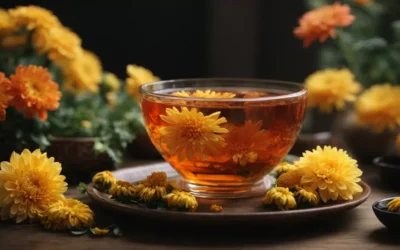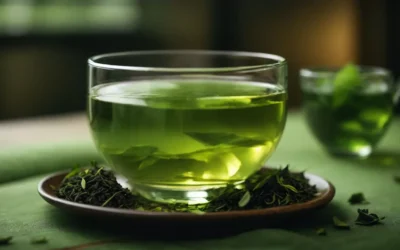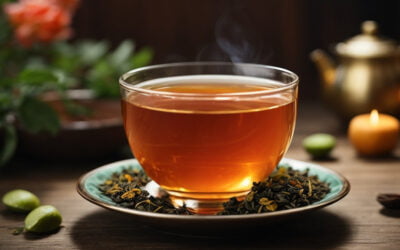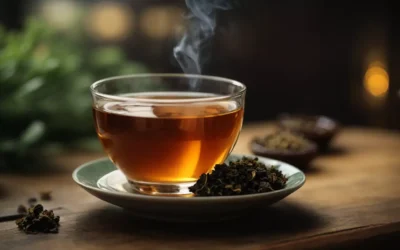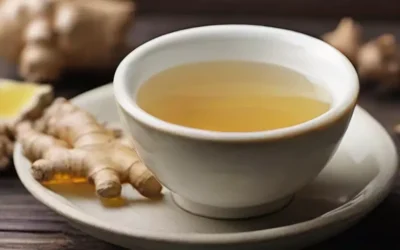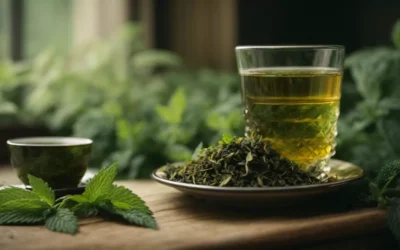Pu-erh tea, originating from China’s Yunnan province, is a revered beverage with a fascinating history and a distinct flavor profile. This fermented tea has captivated tea enthusiasts around the world, thanks to its unique aging process and potential health benefits.
Pu-erh tea undergoes a natural fermentation process that sets it apart from other teas. The leaves are carefully harvested, processed, and then aged for months or even years. This aging process gives pu-erh tea its characteristic earthy, mellow flavor and deep amber color.
Whether you’re a seasoned tea connoisseur or simply curious about expanding your tea repertoire, join us on this journey as we uncover the secrets of pu-erh tea.
- History of Pu-erh Tea
- Cultivation and Regions for Pu-erh Tea Production
- Processing and Fermentation of Pu-erh Tea
- Classification and Grading of Pu-erh Tea
- Ripe and Raw Pu’er
- Aging
- Brewing Techniques for Pu-erh Tea
- Health Benefits of Pu-erh Tea
- Side Effects and Precautions of Pu-erh Tea
- Dosage Guidelines and Consumption Advice
- FAQs
History of Pu-erh Tea
Pu-erh tea has a rich history that dates back over 1,700 years to the Tang Dynasty in China. During this time, it was initially used as a tribute tea, meaning it was given as a gift to emperors and high-ranking officials. However, its popularity soon spread beyond the royal courts and gained favor among traders along the ancient Tea Horse Road.
The Tea Horse Road was an important trade route that connected Southwest China with Tibet and other regions in Central Asia. Traders relied on pu-erh tea for its unique qualities that made it ideal for long journeys. The tea leaves were compressed into bricks or cakes, making them easier to transport over long distances without losing their flavor or quality.
One of the fascinating aspects of pu-erh tea is its discovery in caves. Aged Pu-erh tea bricks have been found in these caves, further emphasizing its historical significance. These aged teas are highly sought after by connoisseurs due to their complex flavors and aromas that develop over time.
Pu-erh Tea as Tribute
During the Tang Dynasty, pu-erh tea held great value as a tribute item. It was considered a luxury product and reserved for special occasions or as gifts to esteemed individuals. This practice continued throughout various dynasties, including the Song and Ming Dynasties.
Popularization Along the Tea Horse Road
As traders traveled along the Tea Horse Road, they discovered the benefits of pu-erh tea for their arduous journeys. The compressed form of the tea allowed them to carry large quantities without taking up much space. Pu-erh’s unique fermentation process gave it a distinct flavor profile that improved with age.
Traders quickly realized that pu-erh tea had excellent market potential due to its durability and desirability among consumers both near and far from China’s borders. Its popularity spread throughout Tibet, Mongolia, and other regions along the Tea Horse Road.
Aged Pu-erh Tea Bricks
The discovery of aged pu-erh tea bricks in caves adds an element of mystery and intrigue to its history. These bricks were often stored in cool, dark environments that allowed them to undergo a natural fermentation process over time. As a result, the tea developed rich flavors and became highly prized by collectors and enthusiasts.
Cultivation and Regions for Pu-erh Tea Production
Pu-erh tea, a unique and distinct variety of tea, is primarily cultivated in the Yunnan province of China. This region is renowned for its favorable climate and fertile soil, which contribute to the exceptional quality of pu-erh tea.
Yunnan Province: The Perfect Environment for Pu-erh Tea
Yunnan’s mild temperatures, high humidity, and abundant rainfall create an ideal environment for growing pu-erh tea. These climatic conditions allow the Camellia sinensis plants to thrive and develop their distinctive flavors. The high altitude of the Yunnan mountains adds another layer of uniqueness to pu-erh tea production.
Renowned Regions: Xishuangbanna, Simao, and Lincang
Within the Yunnan province, several regions are particularly renowned for producing high-quality pu-erh teas. Let’s take a closer look at three notable areas:
- Xishuangbanna: Located in southern Yunnan, Xishuangbanna is often referred to as the birthplace of pu-erh tea. Its lush forests and diverse ecosystem provide an excellent habitat for tea trees to flourish. The combination of fertile soil and a subtropical climate gives Xishuangbanna-grown pu-erh teas their characteristic smoothness and rich flavor profiles.
- Simao (Puer City): Situated in central Yunnan, Simao has gained recognition as one of the major centers for pu-erh tea production. The region’s mountainous terrain contributes to its unique microclimates that support diverse cultivation practices. Simao-grown pu-erh teas are known for their robust flavors and earthy undertones.
- Lincang: Located in western Yunnan near the border with Myanmar, Lincang is another significant region for pu-erh tea cultivation. Its high elevation, coupled with a temperate climate, creates the ideal conditions for growing exceptional pu-erh teas. Lincang-grown pu-erh teas are often prized for their complex flavors and smooth textures.
Cultivation of Pu-erh Tea: Camellia sinensis Varieties
The Camellia sinensis plant has different varieties that are used to cultivate pu-erh tea. These varieties are important because they have unique characteristics that make the tea taste different. The farmers carefully choose the right variety of plants to grow the best pu-erh tea.
Processing and Fermentation of Pu-erh Tea
Pu-erh tea, known for its unique flavor and health benefits, undergoes two main processing methods: raw (sheng) or ripe (shou). Let’s take a closer look at how this tea is processed and fermented to achieve its distinct characteristics.
Picking, Withering, Rolling, and Drying
The first step in the processing of pu-erh tea involves carefully picking the leaves from the Camellia sinensis plant. Only the young leaves and buds are selected to ensure optimal taste and quality. After picking, the leaves go through a withering process where they are spread out to wilt naturally. This helps reduce moisture content and initiate enzymatic reactions that contribute to the development of flavors.
Once withered, the leaves are rolled by hand or using machines to break down their cell walls. This rolling action releases enzymes and essential oils, further enhancing the aroma and taste of the tea. Following rolling, the leaves are either sun-dried or pan-fired to halt oxidation. Sun-drying allows for a slower drying process under natural sunlight, while pan-firing involves quickly heating the leaves in large pans over controlled heat.
Raw Pu-erh: Natural Aging Over Time
Raw pu-erh tea is left unprocessed after drying and undergoes a natural aging process over an extended period. The dried leaves are compressed into cakes or bricks before being stored in a cool environment with controlled humidity levels. During storage, microbial activity occurs within these compressed cakes due to residual moisture present in the leaves.
As time passes, beneficial bacteria and fungi interact with the tea leaves, initiating fermentation processes that transform raw pu-erh into a more complex flavor profile. This aging process can last for several years or even decades depending on personal preference. The longer it ages, the more mellow and smooth its taste becomes.
Ripe Pu-erh: Accelerated Fermentation
Unlike raw pu-erh, ripe pu-erh tea undergoes an accelerated fermentation process. After the initial processing steps of withering, rolling, and drying, the leaves are piled up in a controlled environment with high humidity and temperature. This creates conditions ideal for microbial activity to thrive.
During this fermentation stage, beneficial microorganisms break down complex compounds within the tea leaves, resulting in chemical changes that enhance its flavor and aroma. The pile is carefully monitored and periodically turned to ensure even fermentation throughout.
Classification and Grading of Pu-erh Tea
Pu-erh tea comes in various forms, and its classification is based on several factors, including origin, processing method, age, and quality. Let’s take a closer look at the different classifications and grading systems for Pu-erh tea.
Origin-based Classification
One way to classify Pu-erh tea is by its place of origin. There are two main types: Yunnan Pu-erh tea and Non-Yunnan Pu-erh tea. Yunnan Pu-erh tea refers to teas produced in the Yunnan province of China, which is known as the birthplace of Pu-erh. Non-Yunnan Pu-erh teas are produced outside of this region but still follow similar processing methods.
Processing Method-based Classification
Pu-Erh teas can also be classified based on their processing methods. The most common types include:
- Loose Leaf Teas (Mao Cha): These teas consist of loose leaves that have undergone minimal processing after being harvested.
- Pressed Cakes (Bing Cha): This type involves compressing the leaves into cake-like shapes using molds or other tools.
- Tuocha-shaped Teas (Tuocha): Tuocha refers to small bowl-shaped teas that are compressed into a nest-like form.
Each type offers a unique flavor profile and brewing experience, allowing tea enthusiasts to explore different variations within the world of Pu-erh.
Age-based Classification
Another significant aspect of classifying Pu-erh tea is its age. The aging process plays a crucial role in developing the distinct flavors and characteristics associated with this type of tea. Generally, there are three categories based on age:
- Raw or Green Pu-Erh: This refers to freshly processed teas that haven’t undergone extensive aging.
- Ripe or Fermented Pu-Erh: These teas have undergone a fermentation process that can last several months to years, resulting in a darker color and earthy flavor.
- Aged Pu-Erh: These are Pu-erh teas that have been stored for an extended period, often for decades. The aging process imparts unique flavors and complexities to the tea.
Quality Grading
To assess the quality of Pu-erh tea, various grading systems are used.
Ripe and Raw Pu’er
Raw pu’erh, also known as green pu’erh, undergoes a slow aging process without fermentation. On the other hand, ripe pu’erh, also called cooked or black pu’erh, undergoes an accelerated fermentation process to mimic the effects of aging. These two types of pu’erh teas have distinct flavor profiles due to their different processing methods.
Raw Pu’erh: The Green Tea Experience
Raw pu’erh is like the rebellious teenager of the tea world. It’s unfermented and left to age slowly over time. This type of pu’erh is often made from young tea leaves that are plucked from ancient tea trees in Yunnan Province, China.
The leaves are then carefully processed by withering them under the sun or using indoor techniques. After this initial step, they undergo a pan-frying process to halt oxidation and preserve their vibrant green color. Finally, the leaves are rolled and dried before being compressed into various shapes such as cakes or bricks.
The slow aging process of raw pu’erh allows it to develop complex flavors over time. When brewed, it offers a light and refreshing taste with floral notes and a hint of bitterness. Some even describe it as having a grassy or vegetal flavor profile.
Raw pu’erh is highly regarded for its health benefits. It contains antioxidants that can help boost your immune system and promote overall well-being. It has been claimed to aid digestion and support weight loss efforts.
Ripe Pu’erh: The Dark Side
Ripe pu’erh takes a different path altogether. Its fermentation process is accelerated through techniques such as wet piling or composting. This speeds up the aging process and gives ripe pu’er its distinctive dark coloration.
To produce ripe pu’er, mature tea leaves are harvested from older trees and then processed similarly to raw pu’erh. However, the leaves are left to ferment in a controlled environment for several months or even years. This fermentation process creates a unique flavor profile that is often described as earthy, smooth, and mellow.
The aging effects of ripe pu’erh are meant to mimic those of raw pu’erh that has been aged naturally for many years. This makes it an attractive option for those who want to experience the flavors of aged pu’erh without waiting for decades.
Aging
Aging is a crucial step in the production of pu-erh tea. During this process, microbial fermentation takes place within the tea leaves, resulting in complex flavors and aromas that are characteristic of pu-erh teas. Pu-erh teas can be aged for several years or even decades to enhance their taste and value.
Microbial Fermentation
One of the key factors that sets pu-erh tea apart from other types of tea is the microbial fermentation that occurs during aging. This natural fermentation process involves the action of microorganisms on the tea leaves, which leads to chemical changes in the composition of the tea.
Complex Flavors and Aromas
The microbial fermentation that takes place during aging contributes to the development of unique and complex flavors and aromas in pu-erh tea. As time passes, these flavors become more pronounced and refined, creating a rich and satisfying drinking experience.
Mellowing Effect
Aging has a mellowing effect on pu-erh tea. The initial bitterness and astringency often associated with young pu-erh gradually diminishes over time as the tea undergoes fermentation. This mellowing effect results in a smoother and more enjoyable cup of tea.
Enhanced Taste and Value
Pu-erh teas can be aged for varying lengths of time, ranging from a few years to several decades. As they age, these teas develop deeper flavors, increased complexity, and greater depth. This enhancement in taste makes aged pu-erh highly sought after by tea connoisseurs around the world.
Investment Potential
Due to its ability to improve with age, pu-erh tea has gained popularity among collectors as an investment asset. Aged pu-erh teas can appreciate significantly in value over time, making them not only enjoyable beverages but also valuable assets for those who choose to invest in them.
Proper Storage
To achieve optimal aging, pu-erh tea needs to be stored properly. The storage conditions play a crucial role in the fermentation process and the development of desirable flavors. Pu-erh should be stored in a cool, dark, and well-ventilated environment with controlled humidity levels.
Longevity of Aging
The length of time for which pu-erh tea is aged can vary depending on personal preference and desired flavor profiles. Some teas may only require a few years of aging to reach their peak, while others can benefit from decades-long aging processes.
Brewing Techniques for Pu-erh Tea
Brewing pu-erh tea is an art that requires careful attention to detail. To fully enjoy the unique flavors and benefits of this aged tea, it’s essential to follow the proper brewing techniques. Let’s explore some key aspects of brewing pu-erh tea.
Rinsing the Leaves
Before steeping pu-erh tea, it is customary to rinse the leaves briefly with hot water. This step helps remove any impurities or dust that may have accumulated during storage. Simply pour hot water over the leaves in a teapot or gaiwan, then immediately discard the water. This initial rinse prepares the leaves for optimal flavor extraction during subsequent brews.
Water Temperature and Steeping Time
The ideal water temperature and steeping time for pu-erh tea can vary depending on factors such as the type of pu-erh (raw or ripe) and personal preference. For raw pu-erh, which undergoes minimal processing, a higher water temperature between 195°F (90°C) and 205°F (96°C) is recommended. Steeping times can range from 30 seconds to several minutes, depending on the desired strength.
Ripe pu-erh, also known as cooked or fermented pu-erh, typically requires lower water temperatures ranging from 185°F (85°C) to 195°F (90°C). The steeping time for ripe pu-erh can be longer compared to raw pu-erh, usually starting at one minute and gradually increasing with subsequent infusions.
It’s important to note that these guidelines are not set in stone; they serve as a starting point for experimentation. Adjusting the water temperature and steeping time allows you to customize your brew according to your taste preferences.
Multiple Infusions
One of the fascinating aspects of brewing pu-erh tea is its ability to be steeped multiple times, with each infusion offering unique flavors and characteristics. This quality is especially prominent in high-quality pu-erh teas.
After the initial rinse, the first infusion of pu-erh tea is often referred to as the “awakening” or “opening” of the leaves. This brew sets the stage for subsequent infusions by releasing initial flavors and aromas. Depending on the type and quality of pu-erh, you can enjoy anywhere from three to ten infusions or more from a single batch of leaves.
Health Benefits of Pu-erh Tea
Pu-erh tea, known for its unique flavor and rich history, offers a range of health benefits that make it a popular choice among tea enthusiasts. Let’s explore some of the potential advantages associated with this remarkable beverage.
Antioxidant Powerhouse
One of the key reasons why pu-erh tea is highly regarded is due to its abundance of antioxidants. These powerful compounds help protect our cells from damage caused by harmful molecules called free radicals. Research suggests that the antioxidants found in pu-erh tea may have anti-inflammatory properties, which can potentially reduce inflammation in the body and contribute to overall well-being.
Digestive Aid and Weight Loss Support
Studies have indicated that pu-erh tea may aid digestion and promote weight loss. The tea contains enzymes that can assist in breaking down fats and improving digestion, making it easier for your body to absorb nutrients from food. Pu-erh tea has been suggested to increase metabolism, helping you burn calories more efficiently.
Cholesterol Regulation
Maintaining healthy cholesterol levels is crucial for heart health, and pu-erh tea may play a role in supporting this aspect of our well-being. Some studies have shown that regular consumption of pu-erh tea can help lower LDL (bad) cholesterol levels while increasing HDL (good) cholesterol levels. This balance contributes to a healthier cardiovascular system.
Heart Health Support
In addition to regulating cholesterol levels, pu-erh tea has also been associated with other heart health benefits. Research suggests that the antioxidants present in this tea may help reduce blood pressure and improve blood circulation. By promoting healthy blood flow and reducing oxidative stress on the cardiovascular system, pu-erh tea may contribute to better heart health overall.
Gut Health Boost
The gut plays an essential role in our overall well-being, affecting everything from digestion to immune function. Regular consumption of pu-erh tea has been linked to improved gut health. The tea contains beneficial bacteria that can support a healthy balance of microorganisms in the gut, promoting optimal digestion and nutrient absorption.
Metabolism Boost
If you’re looking for a natural way to give your metabolism a boost, pu-erh tea might be worth considering. Some studies suggest that the polyphenols found in this tea can help increase metabolism, leading to enhanced calorie burning and potential weight loss.
Side Effects and Precautions of Pu-erh Tea
Pu-erh tea, like any other beverage, may have some side effects and precautions that individuals should be aware of before consuming it. While pu-erh tea has numerous health benefits, it is essential to understand the potential risks associated with its consumption.
Caffeine Content and Sleep Disturbances
One important aspect to consider when consuming pu-erh tea is its caffeine content. Pu-erh tea contains caffeine, which is a natural stimulant found in many beverages such as coffee and tea. While moderate caffeine intake can provide an energy boost and enhance mental alertness, excessive consumption may lead to sleep disturbances or jitteriness in sensitive individuals.
It’s crucial to understand your own tolerance for caffeine and how it affects your body. If you are particularly sensitive to caffeine or have trouble sleeping, it may be wise to limit your intake of pu-erh tea or consume it earlier in the day to avoid interfering with your sleep patterns.
Digestive Issues and Stomach Discomfort
Another potential side effect of consuming pu-erh tea is digestive issues such as stomach discomfort. Some individuals may experience gastrointestinal symptoms if they consume large quantities of pu-erh tea. This could include bloating, gas, or even stomach pain.
If you notice any digestive discomfort after drinking pu-erh tea, it might be helpful to reduce your intake or try different brewing methods. Sometimes adjusting the brewing time or temperature can make a difference in how the tea affects your digestion.
Precautions for Pregnant Women
Pregnant women should exercise caution when considering the consumption of pu-erh tea due to its caffeine content. High levels of caffeine during pregnancy have been associated with an increased risk of adverse effects on fetal development.
It is always recommended for pregnant women to consult their healthcare provider before making any dietary changes or introducing new beverages into their routine. Your healthcare provider can provide personalized advice based on your specific circumstances and help you make informed decisions about consuming pu-erh tea during pregnancy.
Moderation is Key
As with any food or drink, moderation is key. While it offers numerous health benefits, excessive consumption may lead to unwanted side effects. It’s essential to listen to your body and pay attention to how pu-erh tea affects you individually.
Dosage Guidelines and Consumption Advice
Dosage guidelines and consumption advice are crucial for enjoying the maximum benefits of pu-erh tea. It is recommended to start with a lower dosage, gradually increasing it over time to allow your body to adjust. A typical dosage ranges from 1-3 grams per cup of water, steeped for 30 seconds to 2 minutes. However, it’s important to note that individual preferences may vary.
To fully appreciate the unique flavors and aromas of pu-erh tea, it is advisable to experiment with different brewing techniques. Traditional methods include rinsing the leaves before steeping them multiple times, allowing you to experience the evolving taste profile of each infusion. Remember to use water at an optimal temperature, around 195°F (90°C), and choose high-quality pu-erh tea from reputable sources.
Incorporating pu-erh tea into your daily routine can provide numerous health benefits such as aiding digestion, promoting weight loss, and reducing cholesterol levels. However, it’s essential to consume pu-erh tea in moderation as excessive intake may lead to caffeine-related side effects or interact with certain medications. If you have any underlying health conditions or concerns, consult a healthcare professional before incorporating pu-erh tea into your diet.
Now that you have gained insights into dosage guidelines and consumption advice for pu-erh tea, take this opportunity to explore its rich history and cultivation methods. Delve deeper into the world of classification and grading while discovering the art of aging this remarkable beverage. Experiment with brewing techniques and savor the unique flavors that each cup brings forth. Embrace the journey of exploring pu-erh tea’s diverse range while reaping its potential health benefits along the way.
Other Alternative Teas with Health Benefits
When it comes to alternative teas with health benefits, there are plenty of options to explore. Each tea offers its own unique set of advantages, and incorporating them into your routine can be a great way to support your overall well-being. Let’s take a closer look at some popular alternative teas and their potential benefits:
Tea | Health Benefits | Dosage Guidelines |
|---|---|---|
Supports liver health and aids digestion | 1-2 cups daily | |
Rich in antioxidants and may reduce inflammation | 2-3 cups daily | |
Promotes relaxation and may improve sleep | 1-2 cups daily | |
Soothes digestive issues and relieves stress | 1-2 cups daily | |
Calms the mind and promotes better sleep | 1 cup before bedtime | |
Boosts energy levels and supports the immune system | 1-2 cups daily | |
Helps with eye health and may reduce inflammation | 2-3 cups daily | |
Supports respiratory health and may aid in detoxification | 1-2 cups daily | |
Rich in antioxidants and may aid in weight management | 2-3 cups daily | |
Eases nausea and aids digestion | 1-2 cups daily |
It’s important to note that while these teas offer potential health benefits, moderation is key. Here are some general dosage guidelines to keep in mind:
- Start with one cup a day: When trying a new tea, it’s best to start with a small amount to gauge your body’s reaction.
- Gradually increase dosage: If you tolerate the tea well, you can gradually increase your intake to the recommended daily dosage.
- Pay attention to your body: Everyone’s body is different, so it’s essential to listen to how your body responds to the tea. If you experience any adverse effects, reduce or discontinue consumption.
- Consult a healthcare professional: If you have any underlying health conditions or are taking medications, it’s always a good idea to consult with your healthcare provider before adding new teas to your routine.
Remember, while these alternative teas can offer potential health benefits, they should not replace a balanced diet and a healthy lifestyle. Incorporate them as part of a holistic approach to wellness and enjoy the unique flavors and benefits they bring to your daily routine. Cheers to your health!
FAQs
What is pu-erh tea and how is it different from other teas?
Pu-erh tea is a unique type of fermented tea that originates from the Yunnan province in China. Unlike other teas, pu-erh undergoes a special aging process that enhances its flavor and character over time. This fermentation process gives pu-erh tea a distinct earthy, rich, and smooth taste that sets it apart from regular teas.
Is pu-erh tea good for weight loss?
Yes! Pu-erh tea has been known to aid in weight loss. It contains natural compounds called polyphenols and catechins that help boost metabolism, increase fat burning, and reduce the absorption of dietary fat. Incorporating pu-erh tea into your daily routine can be an excellent addition to a healthy lifestyle for those looking to shed extra pounds.
How do I brew pu-erh tea properly?
Brewing pu-erh tea is simple! Just follow these steps:
- Boil water and let it cool slightly.
- Place one teaspoon of loose leaf or one teabag per cup into your teapot or mug.
- Pour the hot water over the leaves and steep for 3-5 minutes.
- Enjoy your delicious cup of pu-erh tea! You can re-steep the leaves multiple times to savor its flavors.
Does pu-erh tea have caffeine?
Yes, pu-erh tea naturally contains caffeine but generally in lower amounts compared to black or green teas. The exact caffeine content can vary depending on factors such as the type of leaves used and brewing time. If you’re sensitive to caffeine, you may want to opt for shorter steeping times or choose aged pu-erhs which tend to have lower caffeine levels.
Where can I buy high-quality pu-erh tea?
For premium quality pu-erh tea, it’s best to purchase from reputable tea retailers or specialized online stores. Look for sellers who source their pu-erh directly from trusted producers in Yunnan, China. Read reviews and check the authenticity of the product before making a purchase. Remember to choose organic and sustainably sourced options whenever possible.
Ready to embark on your pu-erh tea journey? Explore our wide selection of authentic pu-erh teas today and experience the unique flavors and health benefits they offer!


